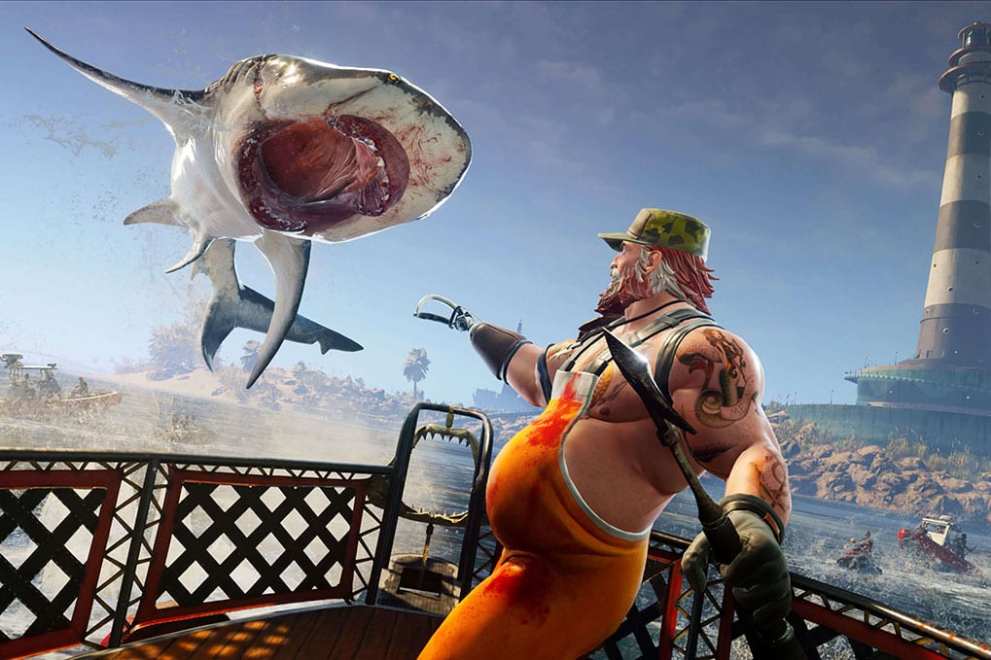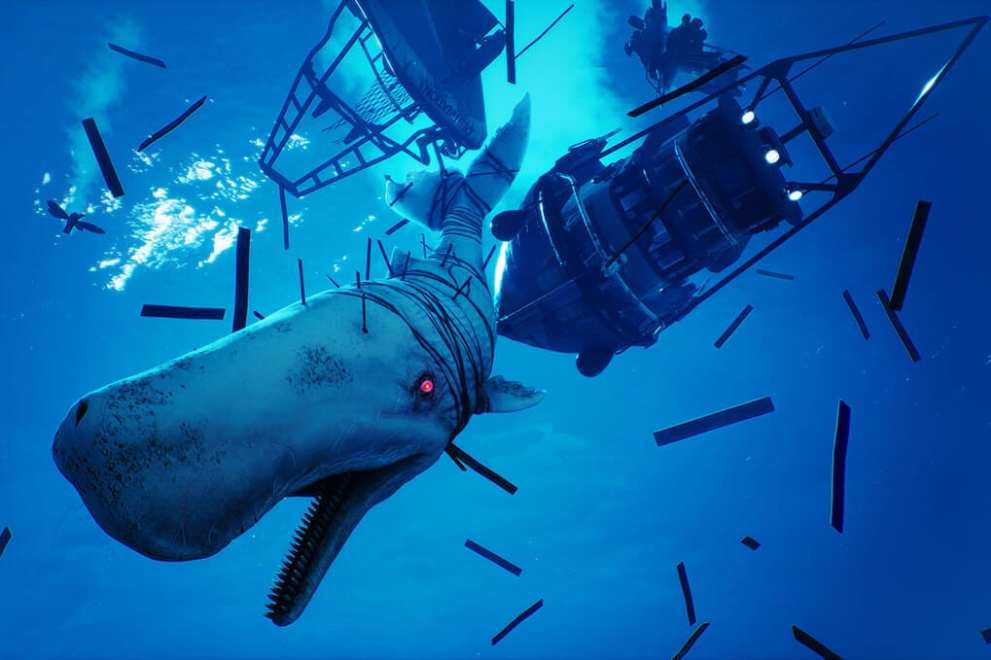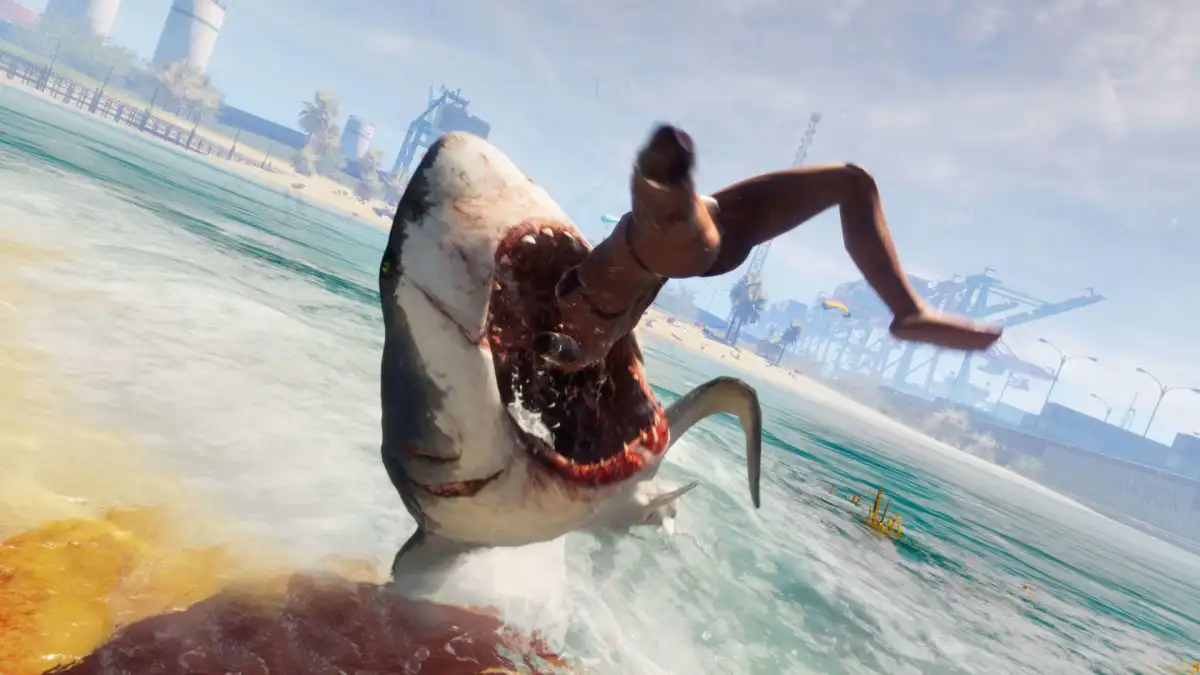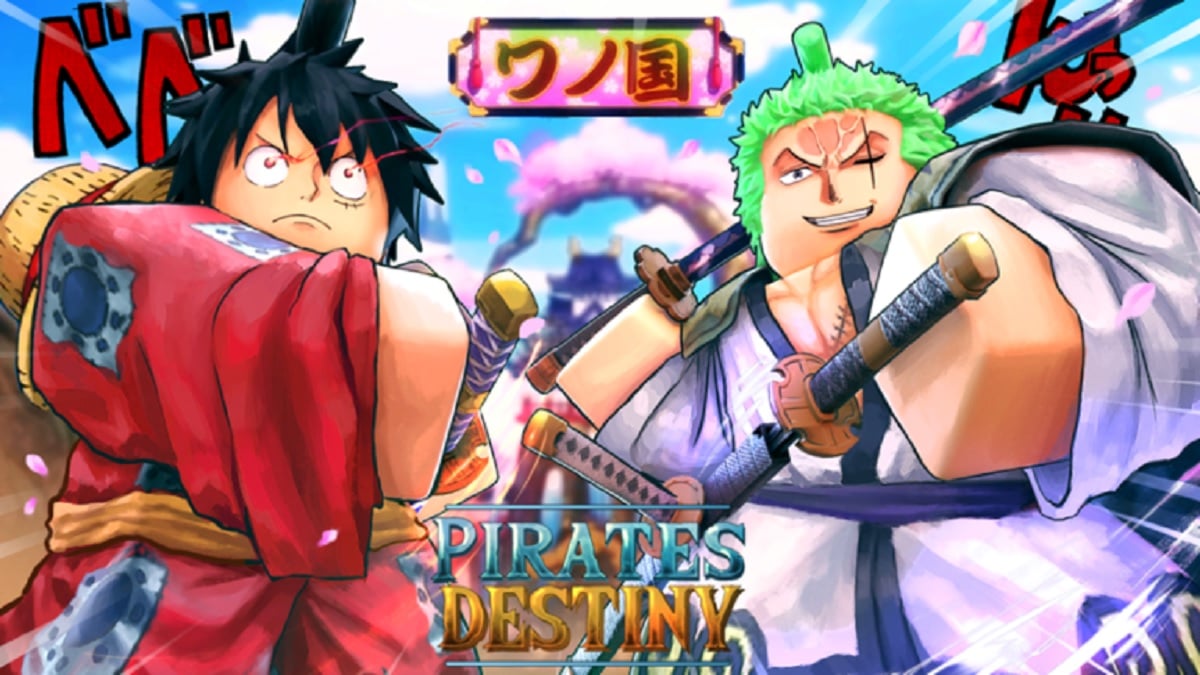Maneater on PlayStation 4
Maneater lies bang in the middle ground between expansive open-world RPG and a dumb shark game. It’s both, without fully leaning into either. Thankfully, it lets you have fun no matter which of the extremes you’re after.
It can be shallow (that’s pun number one), but there’s fun to be had whether you want to explore and grow as a menace of the seas or just swim around biting the shit out of everything.
It’s all framed around a trashy reality show, also called Maneater. Scaly Pete is a shark hunter in what is a vague version of Florida and he kills your mother. After murdering her and pulling you out, you bite his hand off before he marks you so he can find you later on, then chucks you back into the ocean.
From then on, it’s a two-sided story of revenge as you try to grow strong enough to take him on while Pete relishes the time he can fire a harpoon through your skull. It’s not as dark as it sounds, quite the opposite, and sets up a fun framing for what’s to come.
Here is where the RPG-ness of Maneater kicks in. While there’s undoubtedly elements of the dumb shark game the trailer portrays, Maneater is an RPG.
You start as a baby Bull shark and you need to complete quests to level up, unlock upgrades for body parts, collect various currencies, and ultimately evolve into an Adult and Mega Bull Shark.
The structure reminds me a lot of an old Assassin’s Creed game, especially in regards to its world design and use of RPG mechanics. It has all the map icons, designated sections with completion percentages, hidden collectibles, basic find-and-kill missions, and constant XP gaining that the likes of the Ezio trilogy mastered.
There’s nothing especially wrong with that. In fact it’s somewhat refreshing to play an open-world game that’s not overwhelming. Whether that lack of depth will grate on you depends on what you going in expecting. Maneater isn’t a full-price game (starting at $40) and it’s scaled back to match that discount.
Starting off in the shallow bayou and progressing to the deep Gulf, each sector asks you to complete a set of tasks before you’re allowed to move on. Kill 10 of this creature, find this hidden box, hunt for this more powerful version of an enemy you’ve been fighting.
It’s all pretty basic stuff, but it’s the perfect checklist format that lets you chip away at completion, knowing exactly what you need to do and what you’ve got left before you can head on to somewhere new.

The unfortunate repetition comes in the sectors rather than the individual missions. Each of the eight chapters, all of which focus on one sector at a time, have precisely the same objectives. You’re fighting different enemies each time, progressing from Aligator and Baracuda onto Sperm Whales and Great Whites, but the set of objectives never change.
Aside from any XP grinding that you might need to do in the final chapter or collectible clean up at the end, there’s not really any need to return to prior areas, with the objectives being limited to the one you just discovered.
That repetition is curtailed somewhat by the fact that Maneater is generally fun to play. Movement is fast and responsive, the underwater worlds look great (more so than above water), and simply munching through crowds of screaming humans is a blast.
When it comes to humans, it’s just a case of point and bite, but the depth of Maneater is in the fish to fish combat.
There are fodder fish everywhere, each of which gives you some health and DNA currency towards upgrades when you eat them, but each area of the map has its own set of fish that’ll fight back.
Some are more formidable than others, especially in the early sectors before you have any upgrades under your belt, but any and all of them will stalk and rush attack at a moment’s notice.
You need to wait for an opening to attack, not just spamming bite as you would for fleeing humans, and there’s a counter mechanics build in too.
Before and after each attack, the enemy glows, signifying that you can do double the damage with an attack. You can either pounce quickly, risking being caught by a lunge, or evade at the right moment, giving you a chance to counter as they reset. It’s nothing groundbreaking, but there’s significantly more to it than you might expect from a game that presents itself as a campy shark game that lets you eat people.
Fighting larger enemies is a fun duel, it would just have been better if there was some variety to attacks or some way to distinguish better enemy types. They all attack in the same way, with the same patterns, with speed and health the only things to differentiate them.
The open water combat scenarios later in the game are better than the early ones too. Fatwick Bayou, the first area in the game, is shallow, giving you less room to fight the alligators there.
Due to you controlling a lumbering bull shark, which is understandably not the most precise thing in the world, frequently I would pop up to the surface accidentally while trying to turn around, causing me to lose sight of my foe and take some damage.

The open areas around the port and Gulf allow fights to take place over larger bodies of water, making them less frustrating and down to how many mistakes you make rather than the restrictions of the world.
Alongside the quests and RPG grind, there are human enemies to contend with. Maneater employs a GTA style threat and notoriety system in which there are ten levels of Infamy. Kill some members of the public to fill the threat meter up and hunters will be sent out to attack you. Then, as you destroy their boats, you increase your Infamy level and a new special hunter will join the hunt as you tick over between each one.
Then, the level is permanent, meaning you’ll be hunted by larger groups of stronger enemies as you cause more and more chaos. It’s a cool system, adding some risk to swimming around attacking everything, but it’s let down by the poor shark vs. human combat.
Hunters shoot at you almost constantly, with your only way of escape being pressing R1/RB to evade before they’ve locked on. You then need to get close to their boats to bite and ram, which can be cumbersome. If you try to stalk and attack slowly, you’ll be killed, there’s no doubt in that, so the fights are often relegated to you just swimming around hammering evade.
I could only find one reliable tactic, but it went in the opposite direction, making it all far too easy and unrealistic. One of the upgrades, most of which are interesting and useful, adds a percentage boost to the damage you do to anything within two meters while evading.
Level it up and unlock the bone fins and you’re able to smash a boat to shreds without a single clamp of the jaws. Combine that with the bafflingly quick air evade, which is also strangely the quickest way to just navigate the world, and you’re unkillable. Just evade spin vaguely near every enemy vessel until your index finger begins to ache.
In theory, you go from Infamy level 0 to level 10 without stopping and never in any danger of dying. When you’ve had enough, just swim off and carry on with the quests.
If the considered, more shark-like approach was rewarding, maybe I’d stick to it, but using the exploit is the only way to keep hunter combat from being frustrating.
The more chaotic hunter vs. shark fights is also what drew me to Maneater’s other frustrating issue: the frame rate can be horrible, getting worse and worse as you progress.
During busy fights in the later chapters, it slowed to a crawl, occasionally to the point that I’d have to leave what I was doing to let the game calm down and regain its composure. It’s frustrating for that to be so prominent in a game that’s generally so smooth to play.
I also encountered a bug that wiped my save completely when my controller and character died at the same time. Bugs that weren’t frame rate stutters only happened once in the eight hours Maneater took to beat, however, and I’ve been ensured that any game-breaking ones have been fixed for launch.
If you’re after a big dumb shark game, Maneater will scratch that itch. The quality of the gameplay and some of its RPG mechanics might make you wish there was some more depth and variety to it all though.
- - Swimming around eating stuff is dumb fun
- - The world is well designed and underwater looks great
- - The quest, upgrade, progress system keeps you playing
- - Combat is more than just point and bite. You need to think tactically
- - Frame rate issues that get worse as you progress
- - The quests in each sector of the map are repetitive
- - Few differences between how enemies attack






Published: May 22, 2020 09:00 am